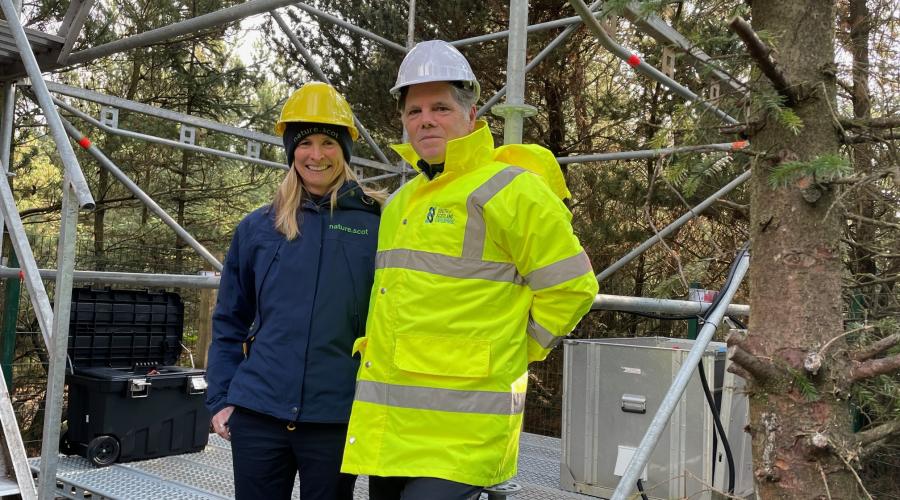
First-ever flux tower installed in the South of Scotland to measure greenhouse gases
14 March 2024
The South of Scotland is joining a national network of flux towers, with a unique project allowing greenhouse gases to be measured as the land changes from commercial forestry crops to restored peatland.
The 14-metre flux tower is the first-ever installed in the South of Scotland and sits within a commercial forestry crop planted upon deep peat soil 24 years ago. Critically, the tower will be the first to measure carbon dioxide and methane from the site as the trees grow, reach maturity and are felled, to see how emissions change as the land is restored back to open peatland.
Greenhouse gases have increased in our atmosphere due to human activity since the industrial revolution, causing the climate crisis. Understanding how Scotland’s land stores or releases these gases is key to reducing carbon emissions.
Peatlands are recognised as vital carbon stores and are the largest terrestrial store of carbon in the UK. Information from the flux tower, funded by NatureScot Peatland ACTION, will help fill critical gaps in the understanding of greenhouse gas emissions from peatlands in different conditions.
Globally, it will put Scotland at the forefront of understanding peatland restoration including how forests impact deep peat. It will also provide critical information for the Scottish Government towards its ambition to reach net zero emissions by 2045.
Data from the flux tower’s instrumentation will also be joined up with a national network of flux towers in Scotland (SCO2FLUX) and shared openly with key stakeholders in peatland restoration and forestry management.
This new flux tower is a collaboration between NatureScot Peatland ACTION, the UK Centre for Ecology & Hydrology, the Crichton Carbon Centre, Forestry and Land Scotland and The James Hutton Institute.
Chris Boyce, from NatureScot’s Peatland ACTION Data & Evidence Team, said: “We are delighted to be funding such an important and ground-breaking addition to Scotland’s flux tower network. The data will help inform the Peatland ACTION Programme on the effectiveness of peatland restoration measures and how to best manage existing peatland carbon stores in the future. Installing the tower is a major milestone and follows years of close collaboration across organisations. It’s fantastic to be moving into the next phase of the project and starting to generate results.”
Dr Emily Taylor, General Manager for the Crichton Carbon Centre, lead partner, said: “It's a really exciting project and the first of its kind in the South of Scotland. To be part of an international network of similar monitoring stations will hugely benefit our understanding of emissions from peatlands under forestry and then subsequently restored and is a step forward in evidencing how we can reach our net zero ambitions.
“This project has been many years in the making and we’re committed to taking on the management of the project and developing this exciting research partnership,” Emily continues. “We hope this tower and research partnership will provide further opportunities for researchers and projects in the South of Scotland.”
Ed Turner, FLS Planning Manager, said:
“The site is part of an extensive lowland raised bog. The trees on this site were planted a quarter of a century ago when the understanding of trees impact on peatland sites was not as developed as it is today. The location of the flux tower is significant in that it will allow greenhouse gas emissions to be measured above the canopy of a maturing second rotation Sitka spruce and lodgepole pine conifer plantation on deep peat.
“This new flux tower will help to further develop our understanding of this extremely complex area and help refine the approach to managing land to best effect.
“Once the trees on this site are felled for timber next decade, there will be no further replanting and the area will be restored to open peatland habitat.”
Dr Carole Helfter, environmental physicist from UKCEH – who have led the installation and setting up of the flux monitoring equipment – explained: “If we are to meet net zero targets, we need to be able to quantify the land’s capacity to sequester carbon and to understand the control mechanisms of greenhouse gas emissions. Adding this project to the flux tower network – designed to help us understand the fundamental drivers for climate change – will give us added clues to that complex puzzle.”
Dr Mhairi Coyle, greenhouse gas and carbon dynamics researcher, from The James Hutton Institute, who are leading on the retrieval and analysis of the flux equipment data, added: “What makes this project so exciting is that, while the equipment will measure carbon dioxide exchange as well as the usual meteorological data, it is also the first tower on forested deep peat measuring landscape-scale methane exchange. Methane is a potent greenhouse gas, and this research will provide additional insights into land management practices that minimise its emission.”
The tower was erected by Dulas, an award-winning renewable energy installer and consultancy. Locally, the project has been supported by Craig Williamson with fencing installation and Clark Scaffolding who will also help monitor the structure.
This project has also benefited from funding from South of Scotland Enterprise.
Updates on the project will be shared on the Crichton Carbon Centre website.




